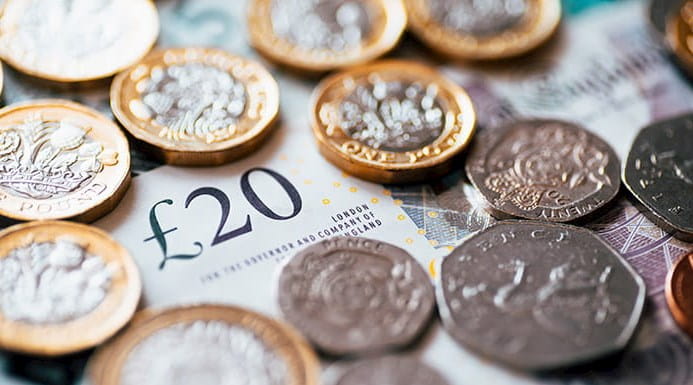After a promising start to 2024, the UK economy stumbled as the effects of high inflation, sluggish growth and global trade frictions took their toll. Revised figures confirm a lacklustre end to last year, with no growth recorded in Q3. Rising energy costs, weak retail and hospitality performance, and stagnation in key industries have left the UK among the worst-performing G7 economies. As inflation creeps higher and interest rate cuts remain uncertain, how do the latest figures shape expectations for the UK’s start to 2025?
UK economy lost momentum at the end of last year

Revised official figures revealed that the UK economy didn’t grow at all in Q3 2024, down slightly from the previous estimate of 0.1% growth. This meant that the UK was joint worst performing G7 economy in Q3. Official monthly figures also revealed that the UK economy shrank by 0.1% in October 2024, matching the decline recorded in September. This was the first monthly back-to-back gross domestic product (GDP) decline since the start of the first COVID-19 lockdown in March 2020 (see Chart 1). Oil and gas extraction, pubs and restaurants, and retail all had a particularly weak October, partly offset by a boost from some sectors, including law and accountancy firms, seeing a rise in work ahead of the autumn budget.
UK inflation on the rise

UK Consumer Prices Index (CPI) inflation rose to 2.6% in November 2024, the highest rate since March 2024 and up from 2.3% in October (see Chart 2). The main upward pressure on the headline rate came from stronger fuel and clothing costs, which was partly offset by the largest November drop in air fares on record. Against this backdrop, the Bank of England kept interest rates unchanged at 4.75% at its December meeting. However, the split 6-3 vote decision in favour of this outcome suggests that a February interest rate cut is very much in play.
Against a backdrop of rising inflation and a stalling economy, what can we expect in the year ahead?
- Government spending to drive slightly stronger growth in 2025
Despite a disappointing end to 2024, UK GDP growth should pick-up this year, mainly because of the higher public spending (much of which is front loaded) announced in October’s budget, which should boost wider activity and employment. While the temporary sugar rush from stronger public spending should help the UK outdo some G7 economies, the squeeze from looming tax rises and growing global uncertainty means that a mid-table finish among these countries is probably the best we can hope for. Although the UK may enjoy a brighter year, sectors such as retail and hospitality face a particularly challenging 2025 with higher insolvencies likely, given their direct exposure to the looming jump in business costs, including April’s rise in national insurance.
- Inflation in 2025 to be a year of two halves
UK inflation is set to rise further in the near term with elevated energy costs, the impact of the Autumn Budget and global trade frictions likely to push the headline rate above 3% by the middle of 2025. Inflation should drift gradually lower thereafter as the downward squeeze on services inflation from slowing wage growth helps moderate underlying price pressures.
- Bank of England to maintain slow and steady approach to interest rate cuts.
While interest rates have further to fall, the timing of policy loosening this year could become increasingly complex, given growing domestic and international inflation risks and stagflation (combination of stagnant economic growth, rising unemployment and rising inflation) fears. Against this backdrop, the Monetary Policy Committee is likely to continue to take baby steps in cutting interest rates, with three or four 0.25% interest rate cuts (taking UK interest rate to 4.00% or 3.75%) the most likely outcome this year.
- Households unlikely to feel materially better off
Any boost to living standards from continued positive real wage growth and improvements to public services is likely to be largely offset by the effects of sticky inflation and high household costs. Any improvement would be in the aftermath of a prolonged period of declining living standards and, as such, households are unlikely to feel any material change. Poor productivity remains the main longstanding barrier to delivering sustainably higher wages and a sustained improvement in living standards.
- Higher, more volatile global prices could become the norm
A key uncertainty for 2025 is how Donald Trump’s new presidency will shape global political and economic events. Higher, more volatile prices could become the norm amid a shift away from globalisation. New US tariffs would not be terminal for the UK economy overall, given that most UK exports to the US are services, which would be largely unaffected by tariffs. However, the damage to the global economy from possible retaliation from other countries in tit-for-tat trade tariffs could notably weaken growth, partly through higher inflation. Elsewhere, Europe’s economy faces a potentially difficult 2025, given the political uncertainty in France and Germany, two of the region’s biggest economies. The outlook for China will largely depend on the success of its stimulus measures in boosting its property market and overall confidence.
UK economy – what to watch for this month
ICAEW’s Business Confidence Monitor, one of the most comprehensive quarterly surveys of UK business activity, will release its findings for the fourth quarter of 2024 on 15 January. On the same day, December’s inflation figures are expected to reveal a slight rise in the headline rate. Meanwhile, the UK GDP figures for November 2024, set to be published on 16 January, are anticipated to show a return to growth following monthly declines in both October and September.



